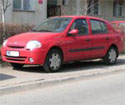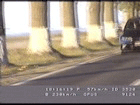RENAULT: SETTING THE STANDARD IN SAFETY WITH
PRODUCTS DESIGNED TO HELP CUSTOMERS DRIVE WITH
CONFIDENCE ON THE ROADS OF TODAY
For over 50 years, Renault has been setting the standard in automotive safety. It draws on real-life accident analysis to design products suited to the realities of the road in each of its target markets worldwide. Furthermore, it acts on customer feedback to ensure that drivers and passengers alike feel safe in its vehicles. What sets Renault apart from its competitors is its commitment to selecting the best technologies for prevention, correction and protection and deploying them out across its line-up. Some practical examples of its safety technology will be exhibited at the Frankfurt Motor Show.
A pragmatic, committed approach
For over 50 years, Renault has invested in research and development of technologies to make its vehicles safer, and has consistently proved itself to be a leader in the field of automotive safety.
It draws on real-life accident analysis to develop products suited to the realities of the road.
This means that it gives priority to the technologies that are best equipped to prevent risk of accident, correct unexpected problems encountered when driving, and protect passengers in the event of a crash.
Every day, Renault's engineers work on every aspect of safety to ensure that both its current line-up and its future vehicles live up to its customers' high expectations. Renault's safety policy is therefore not centred around any one piece of equipment or technology; it is a truly integrated approach.
Renault's top priority is the design of its vehicles: amongst other things, they must have a protective structure, sound, predictable handling, and optimum front visibility. At the end of 2006, Renault performed its 10000th crash test at its technical centre in Lardy, France.
Each year, its test drivers conduct thousands of road tests, sometimes in extreme conditions, in order to study, analyze and perfect the fine-tuning of its vehicle line-up.
Surveys show that customers' perception of safety is based on seven considerations: braking, steering, road holding, visibility, equipment, perceived robustness, and protection of occupants in the event of a crash. Strong performances in these areas give drivers and passengers peace of mind. Focusing on these expectations, Renault strives to offer the best and most suitable equipment for each of its target markets, allowing customers to supplement features offered as standard with additional systems to meet their individual needs. Some examples of such high-tech features will be showcased on the demonstration vehicle at the Frankfurt Motor Show.
The best technology for everyoneRenault draws on its engineering expertise to develop the best possible equipment to face up to real driving situations.
At the Frankfurt Motor Show, a selection of these technologies will be presented in a purpose-built display area. Visitors will be offered an in-depth insight into the systems, how they work, and what their benefits are, through an interactive presentation.
Among the items on display will be two major innovations in the field of protection:
• A world-first on New Laguna: a double side impact sensor, which triggers the vehicle's protection systems twice as quickly as a conventional device and affords excellent protection in the event of a severe side impact.
• The third-generation Renault System for Restraint and Protection (SRP), introduced in 2001. This unique restraint system combines double pretensioners (which restrict forward movement of the body – known as "submarining" – by tightening the lap and chest straps to hold the occupant firmly against their seat), with a load limiter (which reduces the pressure exerted on the chest by the seatbelt) and a twin-volume adaptive airbag (which acts as a final shock absorber).
Some other technologies that visitors will be able to discover or rediscover at the show include:
• Isofix attachments for child safety
• The Emergency Brake Assist system (EBA), which works in harmony with ABS to offer drivers the best possible level of safety, detecting emergency stops and enhancing the performance of the ABS by increasing the pressure applied to the brakes from the moment the driver's foot hits the pedal.
• The Electronic Stability Programme (ESP), which acts on the vehicle's wheels to help the driver maintain their intended course should their vehicle veer off-course or be forced to swerve suddenly.
… not to mention other functions such as the speed limiter, the tyre pressure monitoring system, Xenon headlamp technology and the seatbelt reminder alert – driver assistance systems designed to enable the driver to better identify and anticipate risks and thus prevent dangerous situations from occurring.
sursa:
renault.com![]() Renault: SETTING THE STANDARD IN SAFETY, info.
Renault: SETTING THE STANDARD IN SAFETY, info.


 11 Sep 2007, 13:11
11 Sep 2007, 13:11

 11 Sep 2007, 13:21
11 Sep 2007, 13:21

 11 Sep 2007, 14:33
11 Sep 2007, 14:33













